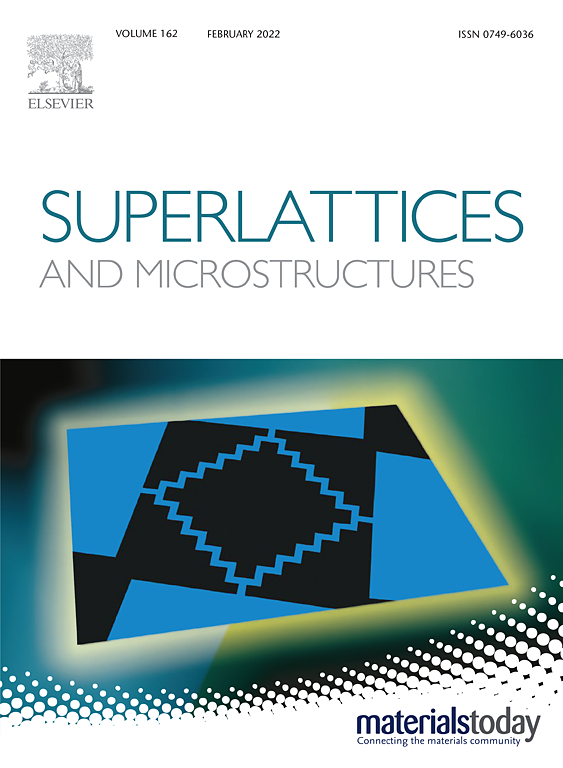水凝胶和多孔支架对Fe3O4纳米颗粒磁性热性能和抗癌效果的影响
IF 3.3
3区 物理与天体物理
Q2 PHYSICS, CONDENSED MATTER
引用次数: 0
摘要
磁热疗利用磁性纳米颗粒(MNPs)在交变磁场(AMF)下将磁能转化为热能,从而提高局部温度以消融癌细胞。MNPs的磁热容量不仅取决于MNPs本身的性质,还受其周围微环境基质的影响。本研究考察了琼脂糖水凝胶和明胶多孔支架对Fe3O4纳米颗粒(NPs)磁性热性能和抗癌效果的影响,并与游离Fe3O4纳米颗粒进行了比较。合成了花状Fe3O4 NPs,并包埋在琼脂糖水凝胶和明胶多孔支架中。在AMF照射下,游离Fe3O4 NPs具有最佳的磁热性能,并能最有效地提高局部温度以消融乳腺癌细胞。然而,在琼脂糖水凝胶和明胶多孔支架中嵌入的Fe3O4 NPs表现出较低的磁热转换能力,并且与游离Fe3O4 NPs相比,在AMF照射下局部温度变化较小。明胶多孔支架比琼脂糖水凝胶具有更高的抑制作用。琼脂糖水凝胶和明胶多孔支架对磁热转换能力的抑制作用导致AMF辐照对乳腺癌细胞的抗癌消融能力下降。Fe3O4 np包埋明胶支架的抗癌效果最低。结果表明,用于递送MNPs的基质会影响其性能,应设计合适的基质以最大限度地提高其生物医学应用的治疗效果。本文章由计算机程序翻译,如有差异,请以英文原文为准。
Influence of hydrogel and porous scaffold on the magnetic thermal property and anticancer effect of Fe3O4 nanoparticles
Magnetic hyperthermia uses magnetic nanoparticles (MNPs) for conversion of magnetic energy into thermal energy under an alternating magnetic field (AMF) to increase local temperature for ablation of cancer cells. The magnetic thermal capacity of MNPs not only depends on the intrinsic properties of MNPs but is also affected by the microenvironmental matrices surrounding the MNPs. In this study, the influence of agarose hydrogels and gelatin porous scaffolds on the magnetic thermal property and anticancer effect of Fe3O4 nanoparticles (NPs) were investigated with a comparison to free Fe3O4 NPs. Flower-like Fe3O4 NPs were synthesized and embedded in agarose hydrogels and gelatin porous scaffolds. Under AMF irradiation, the free Fe3O4 NPs had the best magnetic thermal properties and the most efficiently increased the local temperature to ablate breast cancer cells. However, the Fe3O4 NPs embedded in agarose hydrogels and gelatin porous scaffolds showed reduced magnetic-thermal conversion capacity, and the local temperature change was decreased in comparison to free Fe3O4 NPs during AMF irradiation. The gelatin porous scaffolds showed a higher inhibitory influence than the agarose hydrogels. The inhibitory effect of agarose hydrogels and gelatin porous scaffolds on magnetic-thermal conversion capacity resulted in a decreased anticancer ablation capacity to breast cancer cells during AMF irradiation. The Fe3O4 NP-embedded gelatin scaffolds showed the lowest anticancer effect. The results suggested that the matrices used to deliver MNPs could affect their performance, and appropriate matrices should be designed to maximize their therapeutic effect for biomedical applications.
求助全文
通过发布文献求助,成功后即可免费获取论文全文。
去求助
来源期刊

Superlattices and Microstructures
物理-物理:凝聚态物理
CiteScore
6.10
自引率
3.20%
发文量
35
审稿时长
2.8 months
期刊介绍:
Superlattices and Microstructures has continued as Micro and Nanostructures. Micro and Nanostructures is a journal disseminating the science and technology of micro-structures and nano-structures in materials and their devices, including individual and collective use of semiconductors, metals and insulators for the exploitation of their unique properties. The journal hosts papers dealing with fundamental and applied experimental research as well as theoretical studies. Fields of interest, including emerging ones, cover:
• Novel micro and nanostructures
• Nanomaterials (nanowires, nanodots, 2D materials ) and devices
• Synthetic heterostructures
• Plasmonics
• Micro and nano-defects in materials (semiconductor, metal and insulators)
• Surfaces and interfaces of thin films
In addition to Research Papers, the journal aims at publishing Topical Reviews providing insights into rapidly evolving or more mature fields. Written by leading researchers in their respective fields, those articles are commissioned by the Editorial Board.
Formerly known as Superlattices and Microstructures, with a 2021 IF of 3.22 and 2021 CiteScore of 5.4
 求助内容:
求助内容: 应助结果提醒方式:
应助结果提醒方式:


